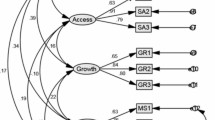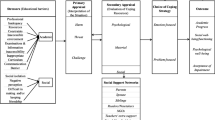Abstract
This study investigated the self-concept of students with visual impairment who were placed in mainstream and specialist secondary schools and vocational courses in South Australia. This research was divided into two stages. In Stage 1, the Tennessee Self-Concept Scale: Second Edition (TSCS: 2) was administered to 25 students with visual impairment. In Stage 2, interviews were conducted with 14 students with visual impairment, 5 parents, and 4 teachers. The great majority of the students with visual impairment obtained very low scores in physical, moral, and personal self-concept. Some students achieved average scores in family, social, and academic self-concept. Interviews were conducted with the three groups of respondents on the dimensions of self-concept (physical, moral, and personal) where students secured very low score on self-concept. The factors responsible for the low self-concept were identified through the interviews. For students with low self-concepts, interventions that include parents and teachers can be especially effective. The findings of this research established that parent participation remains useful and a teacher who maintains more personal contact may also prove valuable. The findings can impact pedagogical practices for students with visual impairment and have implications for policy and practice in the field of special and inclusive education.
Similar content being viewed by others
References
Al-Zyoudi, M. (2007). Gender differences in self-concept among adolescents with low vision. International Journal of Special Education, 22(1), 132–136.
Augestad, L. B. (2017). Self-concept and self-esteem among children and young adults with visual impairment: A systematic review. Cogent Psychology, 4(1), 1–12. https://doi.org/10.1080/23311908.2017.1319652
Beaty, L. A. (1992). Adolescent self-perception as a function of vision loss. Adolescence, 27(107), 707.
Brantlinger, E., Jimenez, R., Klingner, J., Pugach, M., & Richardson, V. (2005). Qualitative studies in special education. Exceptional Children, 71(2), 195–207.
Burns, R. B. (2000). Introduction to research methods (4th ed.). SAGE.
Creswell, J. W. (2008). Educational research: Planning, conducting, and evaluating quantitative and qualitative research (3rd ed.). Pearson/Merrill Prentice Hall.
Datta, P. (2014). Self-concept and vision impairment: A review. British Journal of Visual Impairment, 32(3), 200–210. https://doi.org/10.1177/0264619614542661
Datta, P., & Halder, S. (2012). Insights into self-concept of the adolescents who are visually impaired in India. International Journal of Special Education, 27(2), 86–93.
Datta, P., & Talukdar, J. (2016). The impact of vision impairment on students’ self concept. International Journal of Inclusive Education, 20(6), 659–672. https://doi.org/10.1080/13603116.2015.1111441
Denzin, N. K., & Lincoln, Y. S. (1998). Collecting and interpreting qualitative materials. SAGE.
Duvdevany, I. (2002). Self-concept and adaptive behaviour of people with intellectual disability in integrated and segregated recreation activities. Journal of Intellectual Disability Research, 46(5), 419–429. https://doi.org/10.1046/j.1365-2788.2002.00415.x
Fitts, W. H. (1996). Tennessee self-concept scale: Second edition manual. Western Psychological Services.
Fitts, W. H., & Warren, W. L. (1996). Tennessee self-concept scale (2nd ed.). Western Psychological Services.
Fitts, W. H., & Warren, W. L. (2003). Tennessee Self-concept Scale (2nd ed.) manual. Western Psychological Services.
Garaigordobil, M., & Perez, J. I. (2007). Self-concept, self-esteem and psychopathological symptoms in persons with intellectual disability. Spanish Journal of Psychology, 10(1), 141–150.
Halder, S., & Datta, P. (2012). An exploration into self concept: A comparative analysis between the adolescents who are sighted and blind in India. British Journal of Visual Impairment, 30(1), 31–41. https://doi.org/10.1177/0264619611428202
Jessup, G. M., Bundy, A. C., Hancock, N., & Broom, A. (2018). Being noticed for the way you are: Social inclusion and high school students with vision impairment. British Journal of Visual Impairment, 36(1), 90–103.
Lifshitz, H., Hen, I., & Weisse, I. (2007). Self-concept, adjustment to blindness, and quality of friendship among adolescents with visual impairments. Journal of Visual Impairment and Blindness, 101(2), 96–107.
López-Justicia, D., & del Carmen Pichardo, M. (2009). Self-concept and gender in Spanish low-vision adolescents. Visual Impairment Research, 3(1), 7–16. https://doi.org/10.1076/vimr.3.1.7.4417
Lucy, Y. S. W. (1997). Self-concept of visually impaired students in a mainstream secondary school in Hong Kong (Master’s thesis, The University of Hong Kong [Pokfulam, Hong Kong], Hong Kong). http://hub.hku.hk/handle/10722/28678
Marsh, H. W., & Shavelson, R. (1985). Self-concept: Its multifaceted, hierarchical structure. Educational Psychologist, 20(3), 107–123. https://doi.org/10.1207/s15326985ep2003_1
Miles, M., & Huberman, A. M. (1994). Qualitative data analysis: An expanded sourcebook (2nd ed.). SAGE.
Palmer, C. D. (2003). Social competence of children with albinism. Unpublished PhD thesis, The University of Queensland, Queensland.
Pierce, J. W., & Wardle, J. (1996). Body size, parental appraisal, and self-esteem in blind children. Journal of Child Psychology and Psychiatry, 37(2), 205–212.
Plaskett, L. (2015). Young people with visual impairments and their social inclusion in secondary mainstream settings: Exploring perspectives of the young people, their parents and key professionals. UCL Institute of Education.
Purdie, N., & McCrindle, A. (2004). Measurement of self-concept among Indigenous and non-Indigenous Australian students. Australian Journal of Psychology, 56(1), 50–62. https://doi.org/10.1080/00049530410001688128
Tadić, V., Hundt, G. L., Keeley, S., Rahi, J. S., & Vision-related Quality of Life (VQoL) group. (2015). Seeing it my way: Living with childhood onset visual disability. Child: Care, Health and Development, 41(2), 239–248.
Tracey, D. K., & Marsh, H. W. (2002). Self-concepts of preadolescents with mild intellectual disability: Multidimensionality, measurement, and support for the big fish little pond effect. Self-Concept Research: Driving International Research Agendas, 35, 419–427.
Yousefi, F., Redzuan, M., Mansor, M., Juhari, R., & Talib, M. A. (2010). The effect of test-anxiety on memory among Iranian high school students. International Journal of Psychological Studies, 2(1), 137–141.
Author information
Authors and Affiliations
Corresponding author
Editor information
Editors and Affiliations
Rights and permissions
Copyright information
© 2022 The Author(s), under exclusive licence to Springer Nature Switzerland AG
About this entry
Cite this entry
Datta, P. (2022). Self-Concept of Students with Visual Impairment. In: Baikady, R., Sajid, S., Przeperski, J., Nadesan, V., Rezaul, I., Gao, J. (eds) The Palgrave Handbook of Global Social Problems. Palgrave Macmillan, Cham. https://doi.org/10.1007/978-3-030-68127-2_285-1
Download citation
DOI: https://doi.org/10.1007/978-3-030-68127-2_285-1
Received:
Accepted:
Published:
Publisher Name: Palgrave Macmillan, Cham
Print ISBN: 978-3-030-68127-2
Online ISBN: 978-3-030-68127-2
eBook Packages: Springer Reference Social SciencesReference Module Humanities and Social SciencesReference Module Business, Economics and Social Sciences




